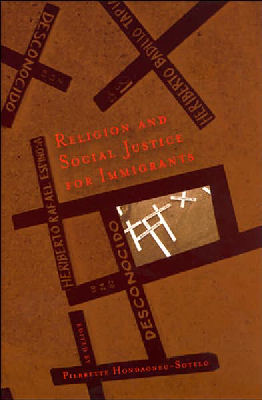
|
Posted February 19, 2007
Book: Religion and Social Justice for Immigrants Edited by Hondagneu-Sotelo Rutgers University Press. New Brunswick, New Jersey. 2007. Pp. 242 An Excerpt from the Jacket:
The essays in this book analyze the different ways in which organized religion provides immigrants with an arena for mobilization, civic participation, and solidarity. Contributors explore topics including how non-Western religious groups such as the Vietnamese Caodai are striving for community recognition and addressing problems such as racism, economic issues, and the politics of diaspora; how interfaith groups organize religious people into immigrant civil rights activists at the U.S. — Mexican border: and how Catholic groups advocate governmental legislation and politics on behalf of refugees. An Excerpt from the Book: Development of the Faith-Based Community Organizing Model While participation in a religious congregation may seem very mundane, I think it is the most significant entry point for an immigrant to participate in American civil society and public life, since religious institutions themselves are considered part of American civil society and give the precitizen a social location for worship, education, culture, ethnic identity, social welfare, recreation, and friendship. In the 1980s Alinsky-inspired community organizers from the Pacifice Institute for Community Organizing (PICO) realized that religious congregations were the most reliable and effective social instruments to organize neighborhoods and communities, particularly with the decline of labor unions, PTAs, and social clubs. They also noticed that immigrants were joining congregations in changing urban neighborhoods — very often revitalizing dying congregations. At the beginning these organizers saw congregations as being ready-made recruitment pools for citywide community organizations. But by the mid-1980s PICO organizers began to rethink the role of the congregation in community organizing as more than a recruitment source. Many pastors and lay leaders resented their congregations being used simply for recruitment and wanted a greater voice on the role of religion in a community organization. The PICO leadership both at national and local levels began to reflect upon the tremendous resource of values, culture, and associational life that congregations carried to sustain membership enthusiasm and loyalty – particularly the role of Catholic social justice teaching and black liberal Protestant biblical justice could play in relationship with the Alinsky method. The concept of faith-based community organizing emerged from this reflective process by PICO organizers. They rediscovered Tocqueville’s emphasis on religion as a first institution and realized that the religious cultural system could generate an ongoing spirit and structure for community organizing, particularly with immigrants and working-class people who trust religious institutions and participate in them. Both the community organization and the religious congregation could assist each other and realize common values an goals in ways that energize both in a synergetic rather than symbiotic relationship. Table of Contents: Part I: Diverse Approaches to Faith and Social Justice for Immigrants 1. Religion and a standpoint theory of immigrant social justice 2. Liberalism, religion, and the dilemma of immigrant rights in American political culture Part II: Religion, civic engagement, and immigrant politics 3. The moral minority, race, religion, and conservative politics in Asian America 4. Finding places in the nation: immigrant and indigenous Muslims in America 5. Faith-based multiethnic, tenant organizing: the Oak Park Story 6. Bringing Mexican immigrants into American faith-based social justice and civic cultures Part III: Faith, Fear, and Fronteras: Challenges at the U.S. - Mexico border 7. The church vs. the state borders, migrants, and human rights 8. Serving Christ in the borderlands: faith workers respond to border violence 9. Religious reenactment on the line: a genealogy of political religious hybridity Part IV: Faith-Based Nongovernmental Organizations 10. Welcoming the stranger: constructing an interfaith ethic of refuge 11. The Catholic church’s institutional responses to immigration: from supranational to local engagement Part V: Theology, Redemption, and Justice 12. Beyond ethnic and national imagination: toward a Catholic theology of U.S. immigration |
|
